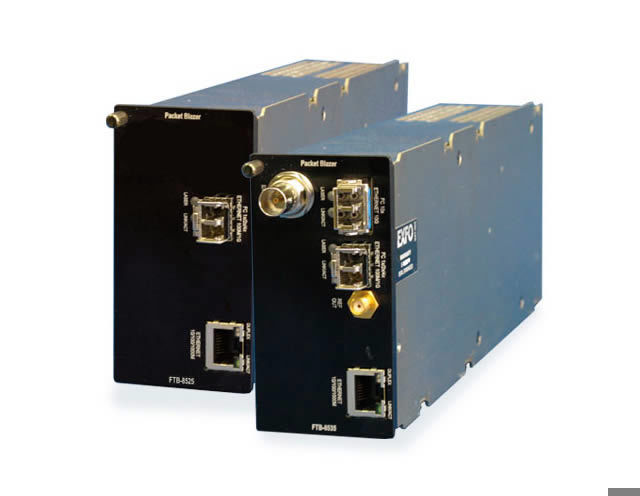Ethernet
- Complete EtherSAM (ITU-T Y.1564) test suite allowing full validation of today’s Ethernet services (bidirectional results through dual test set)
- Bidirectional RFC 2544 (throughput, latency, frame loss and back-to-back) for Ethernet service performance assessment
- Complete Carrier Ethernet services testing portfolio: PBB-TE (MAC-in-MAC), MPLS and IPv4/IPv6
- Up to 10 Gbit/s full-line-rate data capture and decode
- Remote control through Visual Guardian Lite software and VNC
- Packet jitter measurements (IP packet delay variation as per RFC 3393) to qualify Ethernet transport networks for transmission of delay-sensitive traffic such as voice-over-IP (VoIP) and video
- Multistream generation and analysis allowing quality of service (QoS) verification through VLAN and TOS/DSCP prioritization testing
Efficiently assessing performance of Fibre Channel services
FTB-8525/8535 Packet Blazer modules provide comprehensive testing capabilities for Fibre Channel network deployments, supporting multiple Fibre Channel interfaces.
| Interface |
Rate (Gbit/s) |
Rate (MB/s) |
| 1x |
1.0625 |
100 |
| 2x |
2.125 |
200 |
| 4x |
4.25 |
400 |
| 10x (FTB-8535 only) |
10.51875 |
1200 |
Applications
Since most storage area networks (SANs) cover large distances and Fibre Channel has stringent performance requirements, it is imperative to test at each phase of network deployment to ensure appropriate service levels. EXFO’s FTB-8525/8535 modules provide full wire-speed traffic generation at FC-0, FC-1 and FC-2 logical layers, allowing BER testing for link integrity measurements. In addition, latency, buffer-to-buffer credit measurements for optimization as well as login capabilities are supported.
Latency
Transmission of frames in a network is not instantaneous and is subject to multiple delays caused by the propagation delay in the fiber and by processing time inside each piece of network equipment. Latency is the total accumulation of delays between two end points. Some applications such as VoIP, video and storage area networks are very sensitive to excess latency.
It is therefore critical for service providers to properly characterize network latency when offering Fibre Channel services. From the latency measurement that they perform, the FTB-8525/8535 modules estimate buffer-to-buffer credit value requirements.
Buffer-to-buffer credit estimation
In order to regulate traffic flow and congestion , Fibre Channel port s use “buffers” to temporarily store frames. The number of frames a port can store is referred to as a “buffer credit”. Each time a frame is received by a port, an acknowledgement frame is sent. The buffer-to-buffer credit threshold refers to the amount of frames a port can transmit without receiving a single acknowledgement.
This is a crucial configuration parameter for optimal network performance. Usually, network administrators calculate the value by taking the traveled distance and the data rate into consideration; however, since latency issues are not considered, poor accuracy is to be expected. The FTB-8525/8535 modules are capable of estimating buffer credit values with respect to latency by calculating the distance according to the round-trip latency time. This value can then be used by network administrators to optimize the network configuration.
Login testing
Most new-generation transport devices (xWDM or SONET/SDH mux) supporting Fibre Channel are no longer fully transparent; they also have increased built-in intelligence, acting more as Fibre Channel switches. With switch fabric login ability, the FTB-8525/8535 Packet Blazer modules support connections to a remote location through a fabric or semi-transparent networks.
The login process not only permits the unit to connect through a fabric, but it also exchanges some of the basic port characteristics (such as buffer-to-buffer credit and class of service) in order to efficiently transport the traffic through the network.
The login feature allows automatic detection of port/fabric login, login status (successful login, in progress, failure and logout) and response to remote buffer-to-buffer advertised credit.
Ethernet performance validation and reliability
EXFO’s FTB-8525/8535 Packet Blazers offer a wide range of Ethernet test functions aimed at performance validation and reliability testing, supporting multiple Ethernet interfaces, both optical and electrical.
Applications
The FTB-8525/8535 Packet Blazer modules deliver the features required to perform Ethernet service acceptance testing, namely RFC 2544 and BER testing.
| Electrical interfaces |
Optical interfaces |
| 10 Mbit/s |
100 Mbit/s |
| 100 Mbit/s |
1000 Mbit/s (GigE) |
| 1000 Mbit/s |
10 Gbit/s (10 GigE LAN/WAN)—FTB-8535 only |
EtherSAM: the new standard in Ethernet testing
ITU-T Y.1564 is the new standard for turning up and troubleshooting Carrier Ethernet services. This methodology is completely adapted to today’s Ethernet services especially mobile backhaul and commercial services. Up to now, RFC 2544 has been the most widely used methodology. However, it was designed for network device testing in the lab, not for services testing in the field. ITU-T Y.1564 is the first testing standard developed for the field. It has a number of advantages over the RFC 2544 including validation of critical SLA criteria such as packet jitter and QoS measurements. This methodology is also significantly faster, therefore saving time and resources while optimizing QoS.
Contrary to other methodologies, EtherSAM supports new multiservice offerings. It can simulate all types of services that will run on the network and simultaneously qualify all key SLA parameters for each of these services. Moreover, it validates the QoS mechanisms provisioned in the network to prioritize the different service types, resulting in more accurate validation and much faster deployment and troubleshooting. EtherSAM is comprised of two phases, the service configuration test and the service performance test.
Service configuration test
The service configuration test consists in sequentially testing each service. It validates that the service is properly provisioned and that all specific KPIs or SLA parameters are met. A ramp test and a burst test are performed to verify the committed information rare (CIR), excess information rate (EIR), committed burst size (CBS) and excess burst size (EBS).
Service performance test
Once the configuration of each individual service is validated, the service performance test simultaneously validates the quality of all the services over time.
EtherSAM bidirectional results
EXFO’s EtherSAM approach proves even more powerful as it executes the complete ITU-T Y.1564 test with bidirectional measurements. Key SLA parameters are measured independently in each test direction, thus providing 100 % first-time-right service activation—that is the highest level of confidence in service testing.
RFC 2544 testing
In cases where the Ethernet service is delivered via switched transport, the RFC 2544 measurements provide a baseline for service providers to define SLAs with their customers. They enable service providers to validate the quality of service (QoS) delivered in order to create value-added services that can be measured and demonstrated to customers. For example, these tests provide performance statistics and commissioning verification for virtual LANs (VLANs), virtual private networks (VPNs) and transparent LAN services (TLS), all of which use Ethernet as an access technology.
The FTB-8525/8535 Packet Blazer modules come with a complete set of RFC 2544 test capabilities, including:
- Throughput testing
- Burst (back-to-back) testing
- Frame loss analysis
- Latency measurement
BER testing
Because the transparent transport of Ethernet services over physical media is becoming common, Ethernet is increasingly carried across a variety of layer 1 media over longer distances. This creates a growing need for the certification of Ethernet transport on a bit-per-bit basis, which can be done using bit-error-rate testing (BERT). BERT uses a pseudo-random binary sequence (PRBS) encapsulated into an Ethernet frame, making it possible to go from a frame-based error measurement to a bit-error-rate measurement.
This provides the bit-per-bit error count accuracy required for acceptance testing of physical-medium transport systems. In addition to BER testing, the FTB-8525/8535 Packet Blazer modules also provide service disruption time (SDT) measurements.
Ethernet QoS measurements
Data services are making a significant shift toward supporting a variety of applications on the same network. Multiservice offerings such as triple-play services have fuelled the need for QoS testing to ensure the condition and reliability of each service and fully qualify SLA parameters. The FTB-8525/8535 Packet Blazer allows service providers to simultaneously simulate and qualify different applications through its multistream application. The user has the capability to configure up to ten streams with different Ethernet and IP QoS parameters such as VLAN ID (802.1Q), VLAN Priority (802.1p), VLAN stacking (802.1ad Q-in-Q), ToS and DSCP. Specific stream profiles to transmit VoIP, video and data can be selected for each stream. Throughput, latency, frame loss and packet jitter (RFC 3393) measurements are also available simultaneously for each stream, allowing fast and in-depth qualification of all SLA criteria.
MPLS, MPLS-TP and PBB-TE: carrier Ethernet transport solution testing
As technologically-sophisticated business and residential consumers continue to drive demand for premium, high-bandwidth data services such as voice and video, service providers worldwide are evolving their transport infrastructures to support these bandwidth and quality intensive services. No longer is an all-IP core sufficient – providers must now expand their IP convergence to the edge/metro network, in a cost-effective, quality-assured manner. Ethernet has long been accepted as an inexpensive, scalable data networking solution in LAN environments. The stringent quality of service expectations require solutions that tap into the cost-effectiveness of Ethernet without sacrificing the benefit s o f connection-oriented (albeit it costly ) time-division multiplexing (TDM ) solutions such as SONET/SDH.
Ethernet tunneling technologies such as Provider Backbone Bridge-Traffic Engineering or PBB-TE (also referred to as PBT) and transport MPLS address these requirements. These technologies enable connection-oriented Ethernet, providing carriers with a means of offering scalable, reliable and resilient Ethernet services. The PBB-TE and MPLS options on the FTB-8525/8535 Packet Blazer offer service providers a comprehensive field tool to efficiently qualify Ethernet services from end-to-end, validating metro and core tunneling technologies.
TCP throughput
The Internet protocol (IP) and transmission control protocol (TCP) together form the essence of TCP/IP networking. While IP deals with the delivery of packets, TCP provides the integrity and assurance that the data packets transmitted by one host are reliably received at the destination. Applications such as hypertext transfer protocol (HTTP), e-mail or file transfer protocol (FTP) depend on TCP as their delivery assurance mechanism within networks.
Customers deploying such applications expect not only physical and link level SLAs from their service providers, but assurance that their TCP traffic requirements will be supported across the network. The TCP throughput feature on the Packet Blazer™ offers Ethernet service providers the capability of measuring and validating that the services offered to their customers support the TCP traffic performance they expect.
Ethernet advanced troubleshooting
The FTB-8525/8535 provides a number of advanced features essential for in-depth troubleshooting in the event of network failures or impairments. The advanced filtering option allows the user to configure up to ten filters each with up to four operands, which will be applied to the received Ethernet traffic. Detailed statistics are available for each configured filter providing t he us er with critical information required to pinpoint specific problems. Other advanced troubleshooting tools include advanced auto-negotiation and flow control capabilities. Additionally, the FTB-8525/8535 supports a traffic scan feature that allows quick identification and monitoring of VLAN and MPLS flows on the network. This can help clearly identify top bandwidth users.
The FTB-8525/8535 also supports full-line-rate data capture and decode. This key troubleshooting tool enables field technicians to easily identify complex network issues. The comprehensive capture feature includes the capability to configure capture filters and triggers to quickly zero-in on network events.







